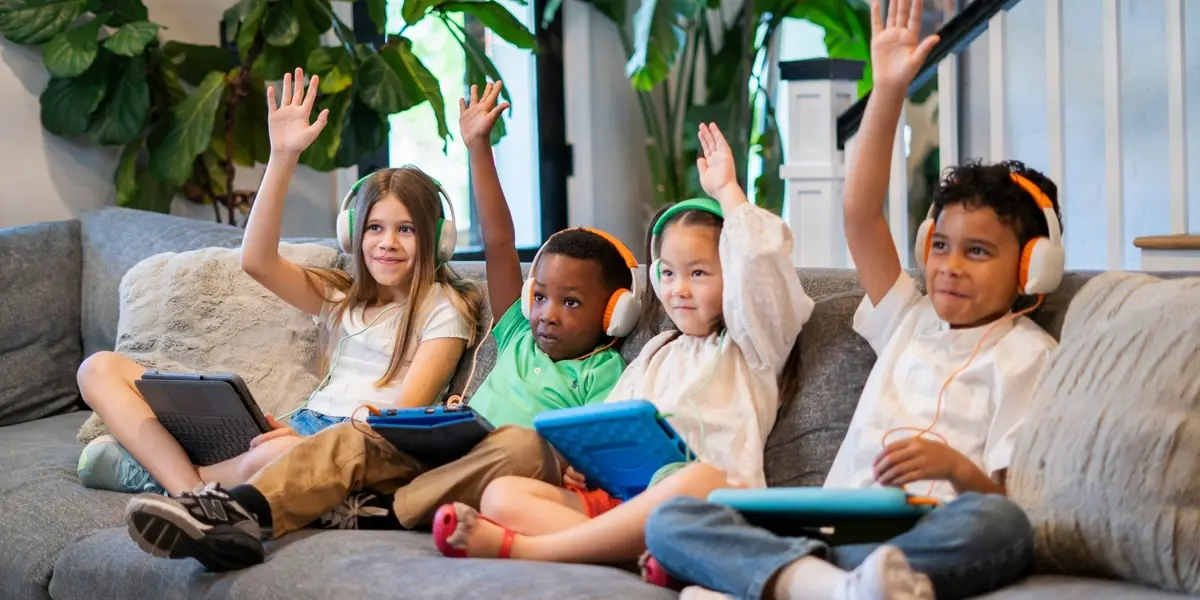The Impact of Audio: Amplifying Early Learning Experiences

Redefining early education, audio and headphones help bring a new dimension to learning. With the daily use of digital curricula in today’s schools, integrating audio and headphones into early learning environments has proven to be a powerful tool. This approach not only enhances traditional teaching methods but also caters to the diverse needs of young learners.
Here, we explore the various benefits of audio and headphones, particularly in improving literacy, assisting children with dyslexia, supporting English as a Second Language (ESL) learners, and enhancing focus and engagement.
Enhancing literacy skills
Audio tools, such as audiobooks and interactive storytelling apps, have shown significant benefits in improving literacy skills among young children. Listening to stories read aloud can help children develop a better understanding of phonetics, vocabulary, and sentence structure. According to Learning Ally, children who are exposed to audiobooks and other audio resources exhibit improved reading comprehension and retention skills.
Headphones can personalize the listening experience, allowing children to focus on the story without external distractions. This focused listening can be particularly beneficial in reinforcing the connection between spoken and written words, thereby enhancing overall literacy.
Assisting children with dyslexia
For children with dyslexia, traditional reading can be a daunting task. Audio resources offer an alternative by providing access to literature without the struggle of decoding text. Studies have shown that listening to audiobooks can help dyslexic children improve their understanding and enjoyment of literature.
Headphones play a crucial role here by providing a controlled auditory environment that minimizes distractions. This helps dyslexic children concentrate better on the content, improving their ability to follow along and comprehend the material.
Supporting ESL learners
ESL learners face unique challenges in mastering both the new language and the academic content delivered in that language. Audio resources, including language learning apps, audiobooks, and podcasts offer a practical solution. These tools provide ESL students with the opportunity to hear the correct pronunciation and usage of words in context, which is essential for language acquisition.
Using headphones can further enhance this experience by immersing students in the language. This immersive experience can significantly improve listening skills, pronunciation, and overall language proficiency.
Improving focus and engagement
Maintaining the attention of young children in a learning environment can be challenging. However, the use of audio tools, coupled with headphones, can significantly improve focus and engagement. Interactive audio content, such as educational games and music, can make learning more enjoyable and engaging for children.
Headphones help create a personal learning space for each child, reducing background noise and distractions. This personalized audio experience can help children stay engaged with the learning material for longer periods, enhancing their overall learning experience.
Integrating headphones into early learning spaces
To maximize the benefits of audio and headphones in early learning spaces, educators and parents may want to consider the following strategies:
- Choose age-appropriate audio content – Select audiobooks, educational apps, and interactive games that are suitable for the child’s age and learning level. Ensure the content is engaging and educational.
- Invest in high-quality, comfortable headphones – Choose headphones that are specifically designed for young children. They should be comfortable, durable, and have volume-limiting features to protect children’s hearing.
- Create a structured audio learning schedule – Incorporate audio sessions into the daily learning schedule. This could include time for audiobooks, language learning, and interactive audio-based activities.
- Monitor and support – Regularly monitor the child’s progress and provide support as needed. Encourage discussions about the audio content to reinforce comprehension and retention.
Choosing the right headphones for children
When selecting headphones for children aged 4-9, it’s essential to focus on safety, design, and durability. Here are some key features to consider.
- Safer sound – Look for headphones with volume-limiting features to ensure the sound level does not exceed safe listening thresholds. Additionally, be mindful to keep listening through headphones to the recommended time per week as advised by the World Health Organization.
- Minimal design – Choose headphones with a simple, user-friendly design that children can easily use and adjust. Avoid overly complex features that may be difficult for young children to manage.
- Durable features and frame – Opt for headphones made from robust materials that can withstand the wear and tear of daily use. Adjustable and flexible headbands, as well as chew-resistant cords, are beneficial for long-term durability.
Above all, finding headphones tailored for children is crucial. Headphones designed for adults may not only fit poorly but also lack the essential features mentioned above. Our award-winning early learning headset, WonderEarsTM, is a great example of a headset made specifically for young listeners.
The impact of audio on early learning
The integration of audio and headphones in early learning spaces offers numerous benefits for young children. By enhancing literacy skills, supporting children with dyslexia, aiding ESL learners, and improving focus and engagement, audio tools and headphones can amplify the learning experience. As educators and parents, embracing these technologies can help create a more inclusive, effective, and enjoyable learning environment for all children.
Tags:
Education & Learning






Comments